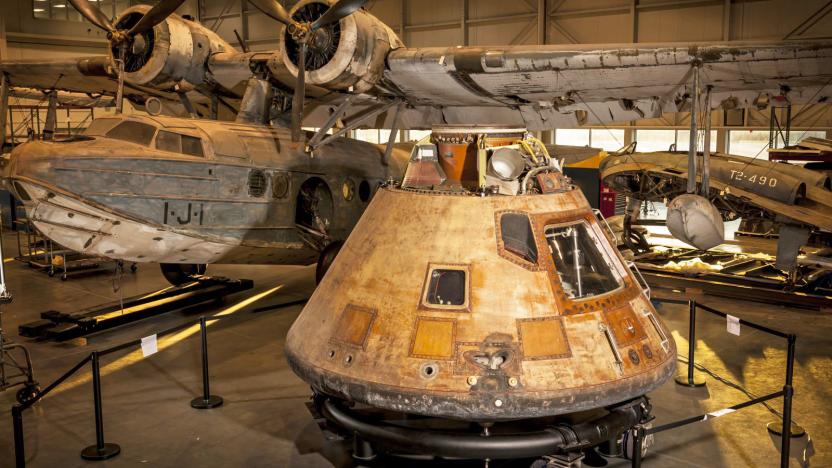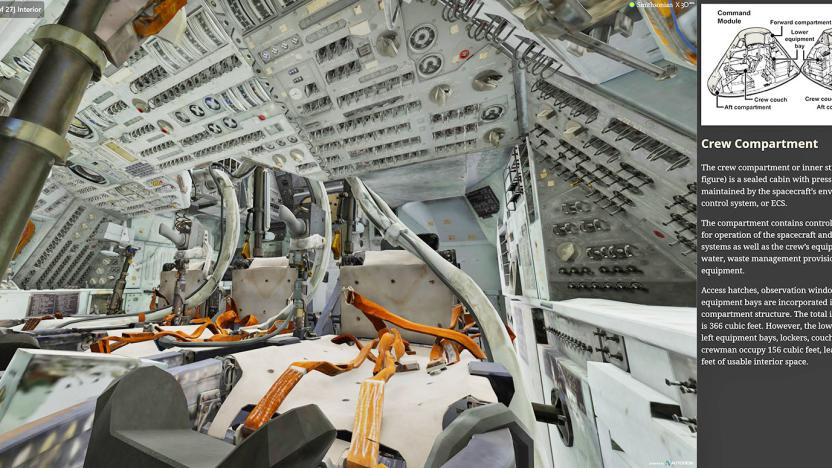moonlanding
Latest

Google recreates Apollo 11's command module with AR
The 50th anniversary of our first successful trip to the moon is fast approaching. And Google, which rarely shies away from marking a significant moment in history, has laid out some of the ways in which it'll celebrate the half-century since Apollo 11 reached the lunar surface.

Lego is releasing an Apollo 11 Lunar Lander set for its 50th anniversary
The 50th anniversary of the human race's first trip to the moon is fast approaching, and Lego is marking the milestone with a NASA Apollo 11 lunar lander set. It'll be available June 1st for $100.

Apollo 11's crew capsule is going on tour
The Apollo 11 space capsule was displayed around the country in 1970 and 1971, shortly after it safely brought Neil Armstrong, Buzz Aldrin and Michael Collins back from their iconic 1969 moon trip. Since then, the command module has lived in the Smithsonian's National Air and Space Museum. Over the next few years, though, the spacecraft will get some fresh air as it embarks on its first national tour in nearly half a century.

Explore a 3D scan of the Apollo 11 capsule
It's been 47 years since NASA first put a man on the moon and you can now get an idea of what astronauts Buzz Aldrin, Neil Armstrong and Michael Collins experienced. The Smithsonian Institute, working with Autodesk, has created a high-resolution 3D scan of "Columbia," the Apollo 11 command module that carried the astronauts to the moon. Using the online viewer (or downloading the virtual reality or 3D print files) you can visit the hidden corners of the module in much more detail than in person at the museum.

Japan is planning an unmanned moon mission for 2019
Japan's space program announced today that it wants to become the fourth country to successfully land an unmanned vessel on the moon. The scheduled launch date is planned for 2019 and even though it seems like the world is focused on Mars and beyond right now, Japan wants to show off the latest in lander technology. The craft will use facial recognition software to drastically increase landing accuracy. The on-board technology can scan the surface of the Moon and make slight adjustments to touch down within 100 meters of the target landing site -- that's dramatically better than anything America, China or Russia have launched. Completing this project will help beef up the country's standing in space exploration. With this said, if it has taken this long for Japan to reach the moon, wonder what year they're going to get to Mars?

Thousands of images from NASA's Apollo missions make it to Flickr
Over the past few months, NASA's been showing us a ton of stunning images of Pluto. And if you thought that was captivating, wait until you see what else has made it onto the web. On Friday, Project Apollo Archive took to Flickr to publish more than 8,400 high-resolution images from NASA's missions to the Moon. The image repository compiles photographs taken by Apollo astronauts during their trips, such as the emblematic Apollo 11 and the final Moon mission, Apollo 17. "Around 2004, Johnson Space Center began re-scanning the original Apollo Hasseelblad camera film magazines, and Eric Jones and I began obtaining TIFF (uncompressed, high-resolution) versions of these new scans on DVD," Kipp Teague, who heads up the project, said to The Planetary Society. "These images were processed for inclusion on our websites, including adjusting color and brightness levels, and reducing the images in size to about 1,000 dpi (dots per inch) for the high-resolution versions."

Neil Armstrong kept the original moon landing camera in his closet
If you were the first to set foot on a celestial body, wouldn't you keep a few mementos from the trip? The great Neil Armstrong certainly did -- including one of the most important gadgets in recent history. The Smithsonian National Air & Space Museum has revealed that the astronaut stored numerous items from the Apollo 11 moon landing in a closet at home, the highlight of which is undoubtedly the 16mm Data Acquisition Camera used to record the iconic moment he reached the lunar surface. Armstrong apparently held onto the camera and other "odds and ends" (as he told Mission Control) on the way back to Earth, and never mentioned them when he returned. Thankfully, you won't have much trouble seeing some of these artifacts in the near future. They're part of an exhibit at the museum, so you only have to book a trip to Washington, DC, by June 8th to see some of the technology that defined early space travel. [Image credit: Dane Penland, National Air and Space Museum, Smithsonian Institution]

NVIDIA's new GPU proves moon landing truthers wrong
Despite overwhelming evidence to the contrary, there still exist some people on planet Earth who believe it's the only celestial body humanity has ever walked upon. You've heard it before -- the moon landing was a hoax, a mere TV drama produced by Stanley Kubrick presented as fact to dupe the Soviet Union into giving up the space race. This deliciously ludicrous conspiracy theory has been debunked countless times, but now its advocates have one more refutation to deny: NVIDIA's Voxel Global Illumination tech demo. It's a GPU-powered recreation of the Apollo 11 landing site that uses dynamic lighting technology to address common claims of moon-deniers, and it's pretty neat.

Revisiting the Apollo 11 Moon landing 45 years later
Today marks the 45th anniversary of the Apollo 11 mission where Buzz Aldrin, Neil Armstrong and Michael Collins made their trip to the Moon. Sure, you could say that there's likely more tech in our pockets than what was used to allow those three to meet their lunar destiny. For whatever reason, though, powering up an Android device or an iPhone isn't nearly as impressive as the fact that we shot humans into outer space and that they walked on the nearest hard surface. Join us as we celebrate that monumental event in the gallery below. For even more, be sure to check out the recent Reddit Ask Me Anything session with Aldrin. Spoiler: he thinks that Gravity is the best depiction of astronauts in zero-G he's ever seen. [Image credit: NASA]

The Big Picture: Preparing for the Moon
During the Apollo program, NASA sent many of its astronauts to Hawaii's Big Island for field training in the run up to missions. The surface of the Moon isn't an environment that's easy to replicate, and the volcanic island chain's barren, rocky terrain is as close as it gets on earth. The picture above shows astronauts from Apollo 17 -- the last manned mission to the lunar surface -- test driving the Moon buggy in 1971. It's one of a series of recently rediscovered images documenting these training exercises, which can be viewed in its entirety here.

China sending a probe to the moon next year to look for Moonbase Alpha
State news agency Xinhua is reporting that China is planning to launch a probe to the moon in the second half of 2013. The Chang'e-3, named after the Chinese moon goddess, will deposit a lander and rover on our natural satellite to survey its bumpy surface. It'll launch from the Xichang Satellite Launch Center in Sichuan province and is a sign of the continuing ambition of the nation's space program -- after it deposited a crew on its Tiangong-1 space station two months ago.

X Prize adopts NASA guidelines for protecting lunar heritage sites, Buzz Aldrin punch averted
NASA hopes that one small step by Google's Lunar X Prize will eventually lead to a giant leap in protecting historical sites on the moon. The X Prize Foundation announced that it will adopt guidelines released by the space agency last year to help preserve lunar heritage sites. The move comes at a crucial time as a new space race increases the possibility of an imminent moon landing, according to NASA. Google's Lunar X Prize alone currently has 26 contestants worldwide vying to land a robot on the lunar surface by 2015. NASA stressed that their recommendations aren't law and "do not represent mandatory U.S. or international requirements." Examples include approach and landing guidelines to minimize disturbance, contamination and degradation of Apollo mission sites. That certainly sounds more reasonable than, say, plopping some dude in a spacesuit at a lunar outpost to shoot trespassers with a plasma shotgun while yelling, "Get off my property!" In the meantime, feel free to mosey on over to the PR after the break.

NASA tests future moon landing robots on Canada's fake moon site
NASA is testing two new robots designed to for future moon landings in a crater in Canada, both of which are equipped with some high end kit designed to analyze their surroundings. Loaded up with "GPS, stereo cameras, laser scanners and sun trackers," the K10 Black and K10 Red can laser map terrain over 3,000 feet away, and fire radar into the ground and detect features up to 16.4 feet down. Running on regular laptop batteries, the robots are able to cover over 120 acres of ground and operate for up to five hours at a time, providing far more information than the restricted space-suit wearing astronauts are able to gather. Now all NASA's gotta do is get the robots onto the moon by the around-2020 date that the adminstration keeps mentioning. [Via The Register]










